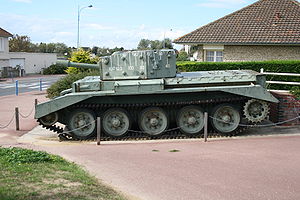- Ordnance QF 95 mm Howitzer
-
Ordnance QF 95 mm Howitzer 
Centaur tank with 95mm gunType Howitzer Place of origin  United Kingdom
United KingdomService history In service 1944 - Used by British Army Wars World War II Production history Designed 1942 Specifications Weight 867 lb (393 kg) Length 7 ft (2.1 m) Shell Fixed Calibre 95 mm (3.7 in) L/18.65 Elevation -5° to +30° Rate of fire 7 rounds per minute Muzzle velocity 330 m/s (1,100 ft/s) Effective range 7,315 m (8,000 yd) The Ordnance QF 95-mm Howitzer was a British Howitzer built in two versions during the Second World War. The Tank Howitzer version was accepted for service use, but an Infantry Howitzer version was not accepted for service use.
Contents
Design and development
The Ordnance QF 95-mm Tank Howitzer was designed to be fitted to British tanks so they could fire a HE or HESH shell against hardened concrete targets like pillboxes in the "close support" of infantry. The 95mm howitzer used fixed ammunition with a 25 lb (11 kg) projectile, rather than separate charge and round common for artillery howitzers. The Tank Howitzer was used to arm the Churchill Mark V and VIII, the Cromwell VI & VIII and the Centaur IV tanks.[1] The Ordnance QF 95 mm Howitzer was built up from a section of a 3.7-inch anti-aircraft gun barrel, the breech mechanism of the Ordnance QF 25 pounder field gun/howitzer and the recoil mechanism of the Ordnance QF 6 pounder anti-tank gun.[2] The Tank Howitzer version was also fitted with a large counterweight at the end of the barrel to help balance the gun.
The only variant of the Centaur tank (a Cromwell tank with a less powerful engine) to see action was the 95 mm armed Mark IV. For the Normandy landings, the Royal Marine Armoured Support Group was formed with an establishment of eighty Mark IVs.
The Ordnance QF 95-mm Infantry Howitzer was a version built as a conventional towed artillery piece. Perhaps in response to the success of the German sIG 33, a proposal was circulated in the summer of 1942 by the British Army for an Infantry Howitzer to be used in a direct-fire role against hardened concrete targets, like pillboxes.[3] The 95 mm Tank Howitzer already under development was considered to be a logical starting point for the design of the new howitzer. The Infantry Howitzer version was similar to the Tank Howitzer, except the Infantry Howitzer lacked the barrel counterweight and was placed on a box-trail carriage and given a gun shield.[4]
Testing in 1943 showed that both the recoil system and the carriage were over stressed and redesign was needed, which delayed testing and introduction of the Infantry Howitzer until 1944. However the problems with the recoil mechanism and carriage were never fully ironed out and the weapon was refused by the infantry and declared obsolete in April 1945, but not before several hundred examples were produced.[5]
The decision to refuse the adoption of the Infantry Howitzer may have not been based entirely on the deficiencies of the gun, but due to perceived obsolescence and organizational difficulties. The introduction of the bazooka and recoilless rifle may have influenced the decision to refuse the gun since they were lighter, less expensive, man portable and fulfilled the direct fire role of the Infantry Howitzer. Organizationally there was also the question of who would man the gun; the infantry already had to support and transport anti-tank guns, anti-aircraft guns, mortars and heavy machine guns. Gun crews would need to be trained and provided with services such as transportation, supply and communications.[6]
Specifications
- Name: Ordnance QF 95mm Infantry Howitzer
- Number built: 800
- Crew: 6
- Calibre: 95 mm (3.7 in)
- Barrel length: 85.5 in (2.17 m)
- Weight in action: 945 kg (2,080 lb)
- Elevation: -5 to +30 degrees
- Traverse: 8 degrees
- Rate of fire: 7 rounds per minute
- Muzzle velocity: 330 m/s (1,100 ft/s)
- Range: 7,315 m (8,000 yd)[7]
- Ammunition
Notes and references
- Notes
- ^ History Of The Second World War
- ^ Twentieth-Century Artillery
- ^ Land Power A Modern Illustrated Military History[page needed]
- ^ Land Power A Modern Illustrated Military History
- ^ Twentieth-Century Artillery[page needed]
- ^ Land Power A Modern Illustrated Military History
- ^ Twentieth-Century Artillery
- Bibliography
- Churchill tank Vehicle History and specification, HMSO
- Hogg, Ian Twentieth-Century Artillery . p.175
- History Of The Second World War Marshall and Cavendish. p.2079
- Land Power A Modern Illustrated Military History. p.210
External links
British and Commonwealth artillery of World War IITank & anti-tank guns QF 2 pounder · QF 6 pounder · OQF 75 mm (tank only) · QF 17 pounder · 77 mm HV (tank only) · QF 3 inch Howitzer · QF 95 mm Howitzer (tank only)Field guns and howitzers Medium and Heavy guns and howitzers BL 60 pounder gun · 4.5 inch Medium Field Gun · 5.5 inch Medium Gun · 6 inch Howitzer · 7.2 inch Howitzer · 8 inch Howitzer · BL 9.2 inch HowitzerMountain guns Anti-aircraft guns QF 2 pounder naval gun · 20 mm Oerlikon · 20 mm Polsten · 40 mm Bofors · QF 3 inch · QF 3.7 inch · QF 4.5 inch Mk II · QF 5.25 inch Mk IICoast defence Railway artillery Categories:- Tank guns
- World War II British guns
- 95 mm artillery
Wikimedia Foundation. 2010.
